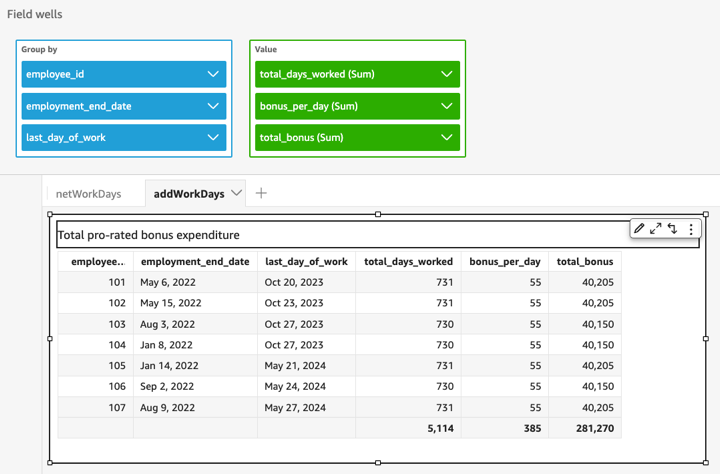addWorkDays
addWorkDays Adds or subtracts a designated number of work days to a
given date value. The function returns a date for a work day, that falls a
designated work days after or before a given input date value.
Syntax
addWorkDays(initDate,numWorkDays)
Arguments
- initDate
-
A valid non-NULL date that acts as the start date for the calculation.
-
Dataset field – Any
datefield from the dataset that you are adding this function to. -
Date function – Any date output from another
datefunction, for exampleparseDate,epochDate,addDateTime., and so on.addWorkDays(epochDate(1659484800),numWorkDays) -
Calculated fields – Any Quick Suite calculated field that returns a
datevalue.calcFieldStartDate = addDateTime(10, “DD”,startDate) addWorkDays(calcFieldStartDate,numWorkDays) -
Parameters – Any Quick Suite
datetimeparameter.addWorkDays($paramStartDate,numWorkDays) -
Any combination of the above stated argument values.
-
- numWorkDays
-
A non-NULL integer that acts as the end date for the calculation.
-
Literal – An integer literal directly typed in the expression editor.
-
Dataset field – Any date field from the dataset
-
Scalar function or calculation – Any scalar Quick Suite function that returns an integer output from another, for example
decimalToInt,abs, and so on.addWorkDays(initDate,decimalToInt(sqrt (abs(numWorkDays)) )) -
Calculated field – Any Quick Suite calculated field that returns a
datevalue.someOtherIntegerCalcField =(num_days * 2) + 12addWorkDays(initDate,someOtherIntegerCalcField) -
Parameter – Any Quick Suite
datetimeparameter.addWorkDays(initDate, $param_numWorkDays) -
Any combination of the above stated argument values.
-
Return type
Integer
Ouptut values
Expected output values include:
-
Positive integer (when start_date < end_date)
-
Negative integer (when start_date > end_date)
-
NULL when one or both of the arguments get a null value from the
dataset field.
Input errors
Disallowed argument values cause errors, as shown in the following examples.
-
Using a literal NULL as an argument in the expression is disallowed.
addWorkDays(NULL,numWorkDays)ErrorAt least one of the arguments in this function does not have correct type. Correct the expression and choose Create again. -
Using a string literal as an argument, or any other data type other than a date, in the expression is disallowed. In the following example, the string
"2022-08-10"looks like a date, but it is actually a string. To use it, you would have to use a function that converts to a date data type.addWorkDays("2022-08-10",10)ErrorExpression addWorkDays("2022-08-10", numWorkDays) for function addWorkDays has incorrect argument type addWorkDays(String, Number). Function syntax expects Date, Integer.
Example
A positive integer as numWorkDays argument will yield a date in
the future of the input date. A negative integer as numWorkDays
argument will yield a resultant date in the past of the input date. A zero value
for the numWorkDays argument yields the same value as input date
whether or not it falls on a work day or a weekend.
The addWorkDays function operates at the granularity:
DAY. Accuracy cannot be preserved at any granularity which is
lower or higher than DAY level.
addWorkDays(startDate, endDate)
Let’s assume there is a field named employmentStartDate with the
following values:
2022-08-10 2022-08-06 2022-08-07
Using the above field and following calculations, addWorkDays
returns the modified values as shown below:
addWorkDays(employmentStartDate,7) 2022-08-19 2022-08-16 2022-08-16 addWorkDays(employmentStartDate,-5) 2022-08-02 2022-08-01 2022-08-03 addWorkDays(employmentStartDate,0) 2022-08-10 2022-08-06 2022-08-07
The following example calculates the total pro-rated bonus to be paid to each employee for 2 years based on how many days each employee has actually worked.
last_day_of_work = addWorkDays(employment_start_date,730) total_days_worked = netWorkDays(employment_start_date,last_day_of_work) total_bonus =total_days_worked*bonus_per_day
